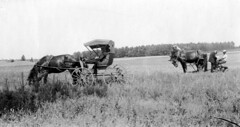 The data from the 1940 United States Census was released on April 2, 2012. It is the most exciting, most anticipated, resource that genealogists are going to be able to dig into this year. Here are some interesting statistics about the 1940 U.S. Census.
The data from the 1940 United States Census was released on April 2, 2012. It is the most exciting, most anticipated, resource that genealogists are going to be able to dig into this year. Here are some interesting statistics about the 1940 U.S. Census.
The release of the 1940 census was so popular that thousands of genealogists flocked to The National Archives website to check it out. This caused a virtual traffic jam that resulted in the website being temporarily shut down. It was getting more hits than the server could process. Susan Cooper, a spokeswoman for The National Archives, said that the website is receiving about 40 million hits per day.
Since April 2, 2012, Americans have downloaded 134 million document images from the 1940 census. That number is 2 million more than the number of Americans who were alive when the census was taken.
It takes 72 years between when a United States Census was taken and when the data from it will be released to the general public. It is my understanding that the purpose of the delay is to prevent identity theft and to protect the privacy of the people who were asked census questions.
Around 21 million people who were counted in the 1940 census tally are still alive today. This equates to one out of every 15 Americans. If the person was born in 1940, than he or she will be turning 72 years old this year. If the person was 20 years old in 1940, then that person is 92 years old this year.
The 1940 census data includes people’s names, ages, and race. A person would identify his or her race by selecting from a series of choices. In the 1940 census, the racial classification system included: “W” for white, “Neg” for Negro, “In” for Indian, “Chi” for Chinese, “Jp” for Japanese, “Fil” for Filipino, “Hi” for Hindu, and “Kor” for Korean.
If a person was not one of these races, then the person had to write in the full name of his or her race. The 1940 census counted people who were Mexican as white, unless that person was also Indian or any other nonwhite race. The 1940 census counted people as Negro if the person had any nonwhite heritage. People who were mulatto were counted as Negro. A person was counted as Indian if he or she had one-fourth or more of “Indian blood”. A person who was a mixture of nonwhite races was counted as the race of his or her father.
The 1940 census also asked people about family relationships, their education, and their birthplace. It asked for details about their employment and income. It also asked for the address of their 1935 residence.
Image by USDAgov on Flickr

